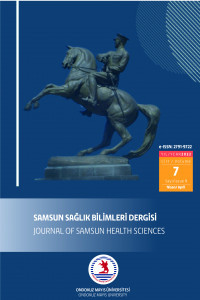GEBELIĞI SONLANDIRMA KARARI: KADIN VE ERKEK PERSPEKTIFI
Kadın, erkek, cinsiyetler arası fark, Gebelik Terminasyonu
The Decision of Terminating Pregnancy: The Male and Female Perspective
Women, man, terminating of pregnancy, gender difference.,
___
- Aksakal, O.S. (2003). Dıstress Subjects Accompanyıng Abortıon and Relıevıng The Anxıety Dependıng These. Tur¬kiye Klinikleri J Med Ethics, 11(1):56-60.
- Awoonor-Williams, J.K., Baffoe, P., Aboba, M., Ayivor, P., Nartey, H., Felker, B., der Tak D.V., & Biney A.A. E. (2020). Exp-loring Conscientious Objection to Abortion Among Health Providers in Ghana. Int Perspect Sex Reprod Health, (46), 51-59. DOI: 10.1363/46e892
- Brauer, M., Ditzhuijzen, J., Boeije, H., & van Nijnatten, C. (2019). Understanding Decision-Making and Decision Dif¬ficulty in Women With an Unintended Pregnancy in the Netherlands. Qual Health Res, 29(8), 1084–1095. doi: 10.1177/1049732318810435
- Costescu, D.J., & Lamont, J.A. (2013). Understanding the pregnancy decision-making process among couples see¬king induced abortion. J Obstet Gynaecol Can, 35(10),899–904. doi: 10.1016/S1701-2163(15)30811-2.
- Cavlin, A., Tezcan, S., & Ergöçmen, B. (2012). Ergöçmen B. Abortion From Women’s Perspective. Nüfus Bilim Dergisi\ Turkish Journal of Population Studies, 34,51-67.
- Gipson, J.D., Hirz ,A.E., & Avila, J.L. (2011). Perceptions and practices of illegal abortion among urban young adults in the Philippines: a qualitative study. Stud Fam Plann. 42(4),261-72. DOI: 10.1111 / j.1728-4465.2011.00289.x
- Hacettepe University Institute of Nüfus Studies. 2013 Turkey Demographic and Health Survey.http://www.hips. hacettepe.edu.tr/eng/TDHS_2013_main.report.pdf). http://www.hips.hacettepe.edu.tr/TNSA2008- main. report.pdf. Date:12.03.2019
- Hacettepe University Institute of Nüfus Studies. 2018 Turkey Demographic and Health Survey. http://www.hips. hacettepe.edu.tr/eng/TDHS_2013_main.report.pdf) . Date:15.04.2020.
- Hardwg, J. (2015). Men and Abortion Decisions. Hastings Center Report 45, 1–5. DOI: 10.1002/hast.432
- Hirz, A.E., Avila, J.L., & Gipson, J.D. (2017). The role of men in induced abortion decision making in an urban area of the Philippines. Int J Gynaecol Obstet, 138(3), 267-271. doi: 10.1002/ijgo.12211. Epub 2017 Jul 11.
- Jones, R.K., Moore, A.M., & Frohwirth, L.F. (2011). Perceptions of male knowledge and support among U.S. women obtaining abortions. Womens Health Issues, 21,117–123.
- Karaoğlan, S., & Duman, M.Z. (2017). The Effects of Relıgıous Belıefs and Attıtudes on Fertılıty (Van Provınce Example). Journal of International Social Research, 10(50), 391-404. https://doi.org/10.17719/jisr.2017.1672
- Kurt, E., & Tunca, Y. (2016). Examining the Ethical Dilemmas in Terminating the Pregnancy Through the Basic Ethical Principles. Med Bull Haseki, 54,57-61. DOI: 10.4274/haseki.2850
- Larsson, Å., & Hilli, Y. (2018). The ethos of caring within midwifery: A history of ideas study. Nursing Ethics, 25(6), 808–818. https://doi.org/10.1177/0969733016669866
- Lee, J.K., Burke, A.E., & Moreau, C. (2018). Female and male decision-making regarding whether to continue or abort an unintended pregnancy: a secondary analysis of the FECOND study. Eur J Contracept Reprod Health Care, 23(4), 311-317. doi: 10.1080/13625187.2018.1506100.
- Naziri, D. (2007). Man’s involvement in the experience of abortion andthe dynamics of the couple’s relationship: a clinical study. Eur J Contracept Reprod Health Care, 12(2):168–174. DOI: 10.1080 / 13625180701201178
- Preventing unsafe abortion. of Reproductive Health and Research World Health Organization Avenue Appia 20, CH-1211 Geneva 27, Switzerland E-mail: reproductivehealth@who.int www.who.int/reproductivehealth. Date:18.07.2019
- Populatıon Plannıng Law Republic of Turkey in 2827. Date of Acceptance: 24/5/1983. Published on R.Gazete: Date: 27/5/1983 Issue: 18059. Published in: Imprint: 5 Volume: 22 Page: 352. http://www.mevzuat.gov.tr/Mevzu¬atMetin/1.5.2827.pdf
- Reich, J.A., & Brindis, C.D. (2006). Conceiving risk and responsibility: a qualitative examination of men’s experien¬ces of unintended pregnancy and abortion. International Journal of Men s Health, 2),133-152. DOI: 10.3149 / jmh.0502.133 Sarıtaş, K. (2012). Ethicality problem of abortion. Int J Soc Sci, 5,587-608.
- Seidu, A., Ahinkorah, B.O., Ameyaw E. K., Hubert, A., Agbemavi, W., Armah-Ansah, E.K., Budu, E., Sambah, F., & Tackie, V. (2020). What has women’s reproductive health decision-making capacity and other factors got to do with pregnancy termination in sub-Saharan Africa? evidence from 27 cross-sectional surveys. PLoS One, 15(7), e0235329. 10.1371/journal.pone.0235329
- Smith, C.S., & Dutta, I. (2014). Termination of pregnancy (TOP). Obstet Gynaecol Reprod Med. 24(7), 221-226. DOI: https://doi.org/10.1016/j.ogrm.2014.04.014
- Steinberg, J.R., Laursen, T.M., Adler, N.E., Gasse, C., Agerbo, E., & Munk-Olsen, T. (2018) Examining the associati¬on of antidepressant prescriptions with first abortion and first childbirth. JAMA Psychiatry, 75,828–834. doi:10.1001/jamapsychiatry.2018.0849
- Vandamme J, Buysse, A., Loeys, T., Vrancken, C., & T’Sjoen, G. (2017). The decision to have an abortion from both partners’ perspectives: a dyadic analysis. Eur J Contracept Reprod Health Care, 22(1), 30-37. DOI:10.1080/ 13625187.2016.1255940
- Vandamme, J., Buysse, A., Loeys, T., Vrancken, C., & T’Sjoen, G. (2017). Correlates of common mental disorders among women who have had an abortion. Perspect Sex Reprod Health, 49, 123–131. doi:10.1363/psrh.12028.
- Van Ditzhuijzen J., Ten Have M., De Graaf R., Van Nijnatten C. H., & Vollebergh W. A. M. (2018). Long-term incidence and recurrence of common mental disorders after abortion. A Dutch prospective cohort study. J Psychiatr Res. 102, 132–135. doi:10.1016/j.jpsychires.2018.04.001
- Yayın Aralığı: Yılda 3 Sayı
- Başlangıç: 2021
- Yayıncı: Ondokuz Mayıs Üniversitesi
VİRAL ENFEKSİYON İLE ENFEKTE OLAN GEBE KADINLARIN DENEYİMLERİ: NİTEL ARAŞTIRMA
Fatma ASLAN DEMİRTAŞ, Meltem MECDİ KAYDIRAK, Ümran OSKAY
ÜRODİNAMİ KAYNAKLI AĞRI VE ANKSİYETENİN KONTROLÜNDE AROMATERAPİNİN ETKİSİ
Elife KETTAŞ DÖLEK, Gülay ALTUN UĞRAŞ
Yetişkin Bireylerin COVID-19 Salgını ile İlgili Bilgi Düzeyi ve Davranış Değerlendirmesi
Hemşire ve Ebelerin Kadınlara Pelvik Kas Egzersizi Öğretimine Yönelik Uygulamaları
Cansu KARADENİZ BENLİ, Nedime Gül DOĞAN ÖZDEMİR, Özen KULAKAÇ
Cilt Bakımında ve Vücut Banyosunda Kullanılan Klorheksidinin Etkisi: Sistematik Derleme
Nazmiye UĞUR, Meryem Türkan IŞIK
Kronik Hastalığa Sahip Bireylerin Hastalığa Uyumunun Yaşam Kalitesi ile İlişkisi
Planlanmamış Gebeliklerin Yaşanma Sıklığı ve Beden İmajına Etkisi
